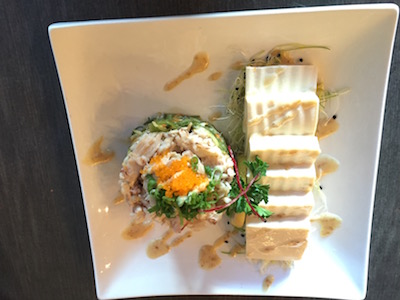Asian Seaweed Salad
Seaweed may first have made American news decades ago as a kooky Asian health food fad, popular with “hippies” but these days the intriguing ingredient has moved onto more sophisticated and fashionable international circles.
Dishes can be as lavish as the tony new grazing dishes on the posh Norwegian Cruise Lines at sea. A small designer plate of mini-soba noodle, seaweed salad and spring rolls is one typical example. The dish caters to guest preferences for more high of a variety of quality raw and ethnic dishes; lighter, smaller portions, and visual appeal.
Ironically, passengers on the luxury liners are probably sailing over beds of the economically and ecologically important marine algae found throughout the world. Long considered a great delicacy in Asia, it is a primary product of aquaculture in China, Korea and Japan (Nori, Kombu and Wakame) with Japanese Nori production worth $2 billion annually.
Though usually thought of as an Asian food ingredient, seaweed has already been gaining popularity around the world in rustic circles. In the British Isles, laver, a purplish-black, wild North Atlantic cousin to nori, is mixed with fat and rolled oats and fried into a breakfast bread.
Health-conscious cooks learned long ago that small amounts of the undiluted sea vegetable, especially readily available fresh and dried Wakame, remain packed with nutrients including vitamins A, C, E, B complex and B12, as well as calcium, potassium, iron, protein, fiber and some omega-3 fatty acids. Watch out for the salt, though, and remember that seaweed originates in the “salty” ocean.
Dried seaweed can be purchased in health food stores, fish markets, Asian markets and online. But a tasty introduction to the freshest and biggest variety of seasweed can still be at a restaurant. Asian restaurant chefs especially long understood the value of seaweed as the earth’s natural bounty, incorporating it as an integral part of both salads and sushi wrappings. One third generation restaurant owner’s mom enticed him into tasting seaweed for the first time by pointing out how smooth the skin of the fish that ate it! Seaweed has always been on his menus because as he explains, “as a child in Korea, my mother taught me that the sea is nature’s storehouse of beauty products, and seaweed is the best.”
Seaweed salads can also be as simple as an on-the-go Asian Market lunch comprised of a package of dried or marinated with soy sauce, black vinegar, sesame oil and sesame seeds. Gyu-Kaku and Chaya Venice Restaurant feature sea soup and salad with seaweed as a minor ingredient to leverage saltiness. Gyu-Kaku’s novelty dishes of Cream Cheese rolled in Seaweed and their solo Crispy Seaweed sheets appeal to the palate because of the combination of textures and the tasty sesame oil coating on the seaweed making them continual best sellers.
The Slow Fish seaweed salad earns honors with mounds of three different kinds of seaweed, shredded carrot, daikon and strips of toasted seaweed and . It feeds all of the senses and has a crunchy texture that makes it fun to eat. The salad became not only a signature dish, but won the downtown community #1 salad award.
The anti-carcinogenic properties of brown seaweeds (kelp) are well noted but not yet understood. The following seaweeds are rich in iron, protein, calcium, zinc and iodine. Hijiki is also a good source of lignans, a substance which helps fight cancer.
Arame is a good introduction to seaweed because of its mild taste and rich source of iron. Capable of blending well with other flavors, and can be steamed, sautéed, added to soup, or eaten in salads.
Hijiki is similar to arame. Hijiki is a black, slightly bitter tasting seaweed and is sold dried in short course strips. Best used in dishes that require slow cooking. Okinawans simmer hijiki with soybeans (after soaking them overnight) and vegetables.
Kombu is a kelp, a brown seaweed cultivated in Japan and eaten both raw and cooked. Kombu is sweet tasting and in the West is used mainly to flavor broths, soups and sauces. Kombu or kelp comes packaged in dried strips. To prepare: cut into smaller strips, add to water and boil for 10 minutes. Use the water as a base for soups or other dishes. Kombu can also be soaked in water and used to wrap around flavored fish and vegetables.
Nori is normally sold in convenient dried sheets. Nori is best used to wrap around small rice balls, which are then dipped in shoyu. After soaking, Nori can be added to soup or used as a salad ingredient.
Wakame kelp looks and tastes like spinach lasagna. Wakame is similar to Kombu and it can be used in many of the same ways, particularly in soup. Best used in salads, added to soup or broth or used as a topping for other dishes. Soaked dry wakame in water expands to about ten times in size. Wakame should have the central vein cut out after soaking. It can then be either simmered for 10 minutes or cut into small pieces and served as a salad.


 Gerry Furth-Sides
Gerry Furth-Sides  Barbara Hansen
Barbara Hansen  Chef-owner Alain Cohen
Chef-owner Alain Cohen  Roberta Deen
Roberta Deen  Jose Martinez
Jose Martinez  Nivedita Basu
Nivedita Basu